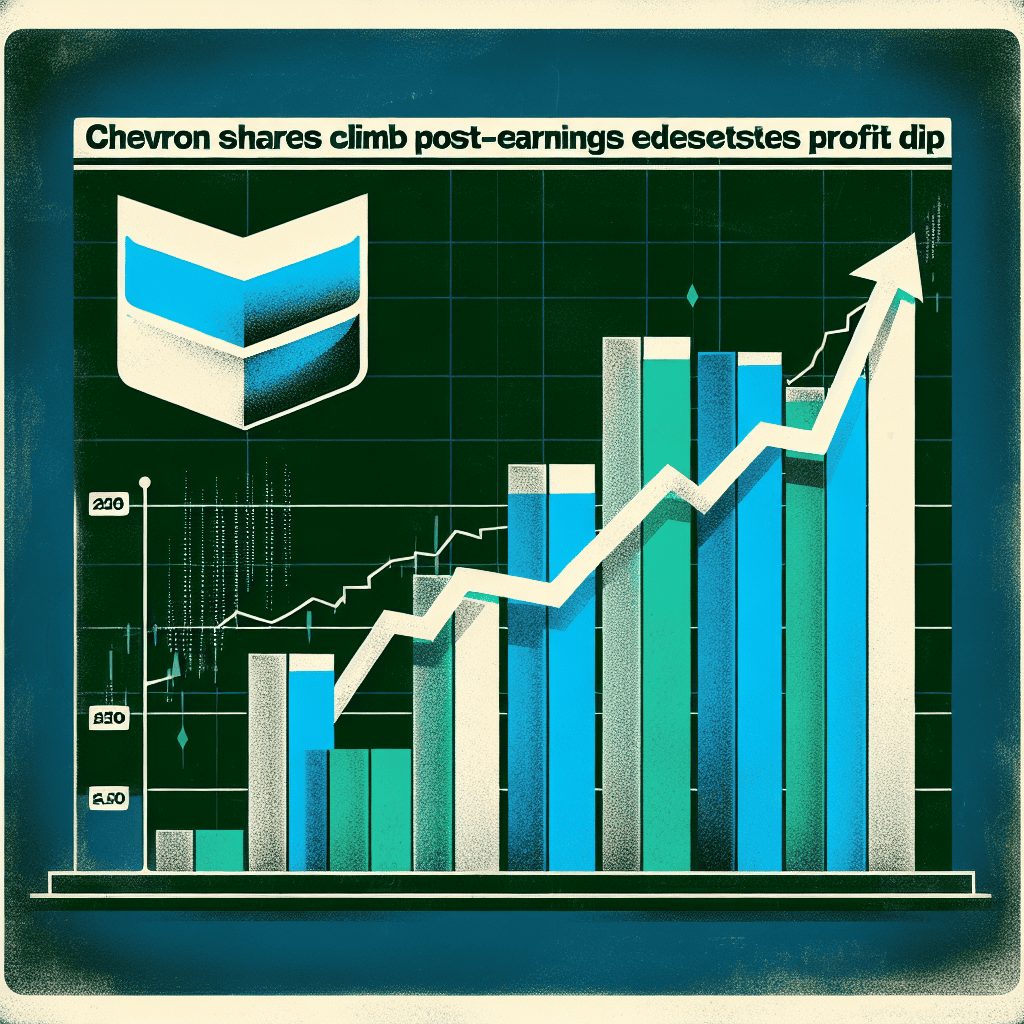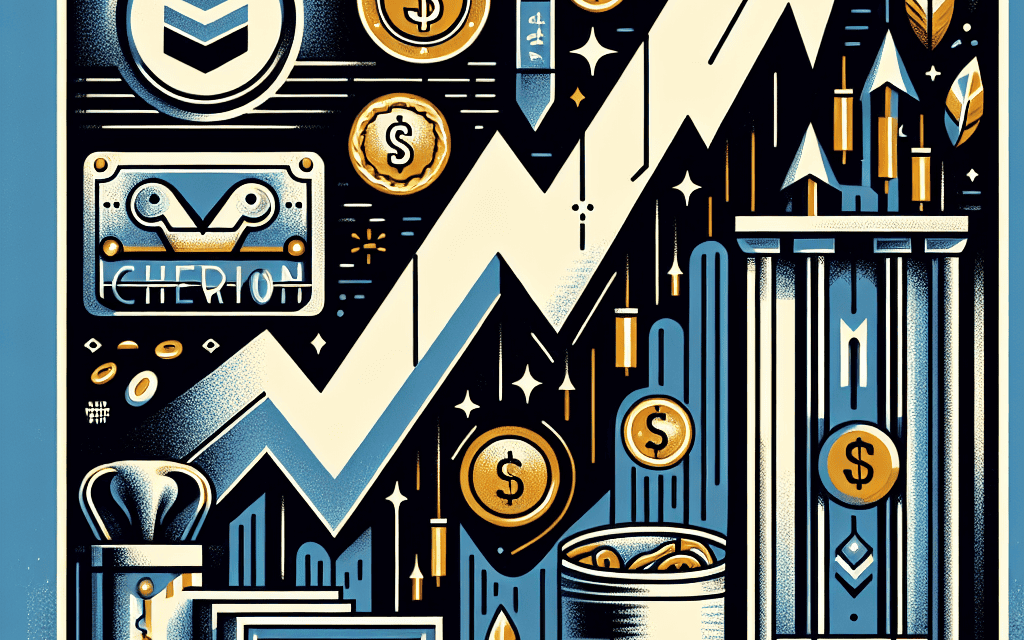“Chevron Shares Rise: Resilience Shines Through Earnings Dip”
Introduction
Chevron shares experienced an upward trajectory following the release of its latest earnings report, despite a noticeable dip in profits. This counterintuitive market reaction can be attributed to several key factors that have bolstered investor confidence. Primarily, Chevron’s strategic operational adjustments and cost-cutting measures have demonstrated resilience in a volatile energy market, reassuring stakeholders of its long-term growth potential. Additionally, the company’s commitment to expanding its renewable energy portfolio has been positively received, aligning with global trends towards sustainable energy solutions. These elements, combined with a robust dividend policy and a strong balance sheet, have contributed to the optimistic outlook among investors, driving the share price higher even in the face of reduced quarterly earnings.
Chevron’s Strategic Investments Drive Share Price Upward
Chevron’s recent earnings report revealed a dip in profits, yet the company’s shares have climbed, reflecting investor confidence in its strategic direction. This seemingly paradoxical market reaction can be attributed to Chevron’s forward-looking investments and strategic initiatives, which have positioned the company favorably in the evolving energy landscape. Despite the profit decline, which was primarily due to fluctuating oil prices and increased operational costs, Chevron’s commitment to long-term growth and sustainability has resonated with investors.
One of the key factors driving Chevron’s share price upward is its strategic investments in renewable energy and technology. As the global energy sector undergoes a significant transformation towards cleaner and more sustainable sources, Chevron has proactively diversified its portfolio. The company has made substantial investments in renewable energy projects, including wind, solar, and biofuels, which are expected to yield significant returns in the coming years. By aligning its business model with global sustainability goals, Chevron is not only mitigating risks associated with fossil fuel dependency but also capitalizing on new growth opportunities.
Moreover, Chevron’s focus on technological innovation has further bolstered investor confidence. The company has been at the forefront of adopting advanced technologies to enhance operational efficiency and reduce environmental impact. For instance, Chevron’s investment in carbon capture and storage (CCS) technology demonstrates its commitment to reducing greenhouse gas emissions. This technology not only helps Chevron meet regulatory requirements but also positions it as a leader in the transition to a low-carbon economy. Such initiatives are crucial in maintaining the company’s competitive edge and ensuring long-term profitability.
In addition to its renewable energy and technology investments, Chevron’s strategic acquisitions have played a significant role in driving its share price. The company’s recent acquisition of a major shale producer has expanded its resource base and strengthened its position in the U.S. energy market. This acquisition is expected to enhance Chevron’s production capabilities and provide a steady revenue stream, offsetting some of the challenges posed by volatile oil prices. By strategically expanding its asset portfolio, Chevron is better equipped to navigate market fluctuations and deliver consistent returns to shareholders.
Furthermore, Chevron’s disciplined financial management has contributed to its positive market performance. The company has maintained a strong balance sheet, with a focus on cost control and capital efficiency. This financial prudence has enabled Chevron to sustain its dividend payouts, which are highly valued by investors seeking stable income. The company’s ability to generate cash flow and maintain shareholder returns, even amid challenging market conditions, underscores its resilience and operational strength.
In conclusion, while Chevron’s recent earnings report highlighted a dip in profits, the company’s strategic investments and initiatives have driven its share price upward. By embracing renewable energy, investing in technology, pursuing strategic acquisitions, and maintaining financial discipline, Chevron has positioned itself as a forward-thinking leader in the energy sector. These efforts not only align with global sustainability trends but also ensure the company’s long-term growth and profitability. As a result, investors remain optimistic about Chevron’s future prospects, reflecting their confidence in the company’s strategic direction and ability to adapt to the changing energy landscape.
Market Confidence in Chevron’s Long-Term Growth
Chevron’s recent earnings report revealed a dip in profits, yet its shares have climbed, reflecting market confidence in the company’s long-term growth prospects. This seemingly paradoxical situation can be attributed to several factors that have reassured investors about Chevron’s future trajectory. Despite the immediate decline in profit, the company’s strategic initiatives and robust operational framework have played a crucial role in maintaining investor trust.
To begin with, Chevron’s commitment to capital discipline and cost management has been a significant factor in bolstering market confidence. The company has consistently demonstrated its ability to navigate volatile market conditions by optimizing its operations and maintaining a strong balance sheet. This financial prudence has allowed Chevron to continue investing in high-return projects, ensuring sustainable growth over the long term. Moreover, Chevron’s focus on reducing operational costs and enhancing efficiency has positioned it well to weather short-term financial setbacks, further reinforcing investor confidence.
In addition to its financial strategies, Chevron’s investments in renewable energy and low-carbon technologies have also contributed to the positive market sentiment. As the global energy landscape shifts towards sustainability, Chevron has proactively embraced this transition by allocating resources to develop cleaner energy solutions. This forward-thinking approach not only aligns with global environmental goals but also opens up new avenues for growth and revenue generation. By diversifying its energy portfolio, Chevron is mitigating risks associated with traditional fossil fuels and positioning itself as a leader in the evolving energy sector.
Furthermore, Chevron’s strategic partnerships and acquisitions have played a pivotal role in enhancing its growth prospects. The company’s recent acquisition of Noble Energy, for instance, has expanded its asset base and strengthened its position in key markets. Such strategic moves have enabled Chevron to capitalize on synergies and unlock additional value, thereby boosting investor confidence in its ability to deliver long-term growth. These partnerships also provide Chevron with access to new technologies and expertise, further enhancing its competitive edge in the industry.
Another factor contributing to the positive market response is Chevron’s strong track record of shareholder returns. The company has consistently prioritized returning value to shareholders through dividends and share buybacks. This commitment to shareholder value has fostered a sense of trust and reliability among investors, who view Chevron as a stable and rewarding investment. Even in the face of short-term profit declines, the company’s ability to maintain its dividend payouts underscores its financial resilience and long-term growth potential.
Moreover, Chevron’s global presence and diversified asset portfolio have provided it with a competitive advantage in navigating market fluctuations. The company’s operations span across various geographies and energy segments, allowing it to leverage opportunities in different markets and mitigate risks associated with regional disruptions. This diversification strategy not only enhances Chevron’s growth prospects but also instills confidence among investors regarding its ability to sustain performance over the long term.
In conclusion, while Chevron’s recent earnings report may have shown a dip in profits, the market’s positive response reflects a broader confidence in the company’s long-term growth potential. Through strategic financial management, investments in renewable energy, strategic partnerships, and a commitment to shareholder returns, Chevron has demonstrated its ability to adapt and thrive in a rapidly changing energy landscape. As a result, investors remain optimistic about the company’s future prospects, driving its shares higher despite short-term financial challenges.
Analyzing Chevron’s Cost Management Amid Profit Decline
Chevron Corporation recently experienced a notable increase in its share price following the release of its latest earnings report, despite a decline in profits. This seemingly paradoxical market reaction can be attributed to the company’s adept cost management strategies, which have reassured investors about its long-term financial health. As the energy sector grapples with fluctuating oil prices and evolving regulatory landscapes, Chevron’s ability to navigate these challenges has become a focal point for stakeholders.
To begin with, Chevron’s earnings report revealed a dip in profits, primarily due to lower oil prices and reduced production levels. However, the company managed to exceed analysts’ expectations, which played a crucial role in boosting investor confidence. This was largely achieved through Chevron’s rigorous cost management initiatives, which have been instrumental in maintaining its competitive edge. By streamlining operations and optimizing resource allocation, Chevron has effectively mitigated the impact of external pressures on its bottom line.
Moreover, Chevron’s strategic focus on cost efficiency has been complemented by its commitment to capital discipline. The company has been judicious in its capital expenditures, prioritizing high-return projects while deferring or divesting non-core assets. This approach has not only preserved cash flow but also enhanced Chevron’s ability to adapt to market volatility. As a result, investors have been reassured by the company’s prudent financial management, which has been reflected in the upward movement of its share price.
In addition to cost management, Chevron’s investment in technology and innovation has further bolstered its operational efficiency. The company has embraced digital transformation initiatives, such as the use of advanced data analytics and automation, to optimize its exploration and production processes. These technological advancements have enabled Chevron to reduce operational costs and improve productivity, thereby offsetting some of the adverse effects of declining oil prices. Consequently, Chevron’s proactive approach to integrating technology into its operations has been a key factor in sustaining investor confidence.
Furthermore, Chevron’s commitment to sustainability and environmental stewardship has also played a role in shaping investor sentiment. As the global energy landscape shifts towards cleaner and more sustainable sources, Chevron has made significant strides in reducing its carbon footprint and investing in renewable energy projects. By aligning its business strategy with the growing demand for sustainable energy solutions, Chevron has positioned itself as a forward-thinking company that is well-equipped to thrive in a transitioning energy market. This strategic alignment with global sustainability trends has resonated positively with investors, contributing to the rise in its share price.
In conclusion, while Chevron’s recent earnings report highlighted a decline in profits, the company’s robust cost management strategies have been pivotal in maintaining investor confidence. Through a combination of operational efficiency, capital discipline, technological innovation, and a commitment to sustainability, Chevron has demonstrated its resilience in the face of industry challenges. As a result, the market’s positive response to Chevron’s earnings report underscores the importance of effective cost management in navigating the complexities of the energy sector. By continuing to prioritize these strategic initiatives, Chevron is well-positioned to sustain its financial performance and deliver long-term value to its shareholders.
Chevron’s Dividend Policy Attracts Investors

Chevron’s recent earnings report revealed a dip in profits, yet its shares have climbed, drawing attention to the underlying factors that have bolstered investor confidence. A key element in this scenario is Chevron’s steadfast dividend policy, which has consistently attracted investors even in times of fluctuating earnings. This policy, characterized by its reliability and growth potential, serves as a cornerstone of Chevron’s appeal to shareholders, providing a sense of stability and long-term value.
Despite the decline in profits, Chevron’s commitment to returning capital to shareholders through dividends remains unwavering. This commitment is particularly significant in the energy sector, where market volatility can often lead to unpredictable financial outcomes. By maintaining a robust dividend policy, Chevron reassures investors of its financial health and strategic foresight. This assurance is crucial, as it signals the company’s ability to generate sufficient cash flow to support its dividend payments, even amidst challenging market conditions.
Moreover, Chevron’s dividend policy is not merely about maintaining payouts; it is also about growth. The company has a track record of increasing its dividends over time, which is a compelling factor for investors seeking income growth. This approach aligns with the interests of long-term investors who prioritize steady income streams and capital appreciation. As a result, Chevron’s dividend policy acts as a magnet for a particular class of investors who value stability and incremental growth over short-term gains.
In addition to its dividend policy, Chevron’s strategic initiatives further enhance its attractiveness to investors. The company has been actively investing in projects that promise future growth, such as its ventures into renewable energy and efforts to improve operational efficiency. These initiatives not only demonstrate Chevron’s adaptability in a rapidly changing energy landscape but also its commitment to sustainable growth. By diversifying its portfolio and embracing innovation, Chevron positions itself as a forward-thinking entity capable of navigating the complexities of the modern energy market.
Furthermore, Chevron’s financial discipline plays a crucial role in supporting its dividend policy. The company has consistently managed its balance sheet prudently, ensuring that it maintains a strong financial position. This discipline is evident in its ability to manage debt levels effectively and optimize capital expenditures. Such financial stewardship instills confidence among investors, as it indicates that Chevron is well-equipped to weather economic uncertainties while continuing to reward shareholders.
In conclusion, Chevron’s shares have climbed post-earnings despite a dip in profits, largely due to its robust dividend policy that continues to attract investors. This policy, underpinned by reliability and growth potential, offers a sense of stability and long-term value that resonates with shareholders. Coupled with strategic initiatives and financial discipline, Chevron’s approach not only reassures investors of its current financial health but also its capacity for future growth. As the energy sector evolves, Chevron’s commitment to its dividend policy and strategic investments positions it as a resilient and attractive option for investors seeking both income and growth.
Impact of Global Oil Prices on Chevron’s Earnings
Chevron Corporation, one of the world’s leading integrated energy companies, recently experienced a notable increase in its share price following the release of its latest earnings report. This rise in stock value occurred despite a dip in profits, a phenomenon that can be largely attributed to the complex interplay of global oil prices and market expectations. Understanding the impact of global oil prices on Chevron’s earnings provides insight into why investors remain optimistic about the company’s future prospects.
To begin with, it is essential to recognize that Chevron’s financial performance is intricately linked to fluctuations in global oil prices. As a major player in the oil and gas industry, Chevron’s revenue is significantly influenced by the price of crude oil, which is subject to a myriad of factors including geopolitical tensions, supply and demand dynamics, and macroeconomic trends. In recent months, global oil prices have experienced volatility due to a combination of these factors, leading to a challenging environment for oil producers.
Despite the dip in profits reported by Chevron, the company’s ability to navigate these turbulent market conditions has been commendable. One of the key reasons for the positive investor sentiment is Chevron’s strategic focus on cost management and operational efficiency. By optimizing its production processes and reducing operational expenses, Chevron has managed to maintain a competitive edge even when oil prices are not at their peak. This approach not only helps in cushioning the impact of lower oil prices on the company’s bottom line but also positions Chevron favorably for future growth when market conditions improve.
Moreover, Chevron’s diversified portfolio of assets plays a crucial role in mitigating the adverse effects of fluctuating oil prices. The company’s investments in natural gas, renewable energy, and other alternative energy sources provide a buffer against the volatility of the oil market. This diversification strategy not only enhances Chevron’s resilience but also aligns with the global shift towards cleaner energy solutions, thereby attracting environmentally conscious investors.
In addition to its operational strategies, Chevron’s financial health and strong balance sheet have contributed to the positive market response. The company has consistently demonstrated prudent financial management, maintaining a healthy cash flow and a robust capital structure. This financial stability reassures investors of Chevron’s ability to weather short-term challenges and capitalize on long-term opportunities in the energy sector.
Furthermore, Chevron’s commitment to shareholder returns through dividends and share buybacks has bolstered investor confidence. Even in the face of profit declines, the company has continued to prioritize returning value to its shareholders, a move that is highly appreciated in the investment community. This commitment underscores Chevron’s long-term vision and its dedication to maintaining shareholder trust.
In conclusion, while Chevron’s recent earnings report revealed a dip in profits, the subsequent climb in its share price can be attributed to a combination of strategic operational management, portfolio diversification, financial stability, and a steadfast commitment to shareholder returns. These factors, coupled with the inherent volatility of global oil prices, paint a comprehensive picture of why investors remain optimistic about Chevron’s future. As the energy landscape continues to evolve, Chevron’s adaptability and forward-thinking approach position it well to navigate the challenges and opportunities that lie ahead.
Chevron’s Expansion Plans and Market Reaction
Chevron’s recent earnings report has sparked considerable interest among investors and market analysts, as the company’s shares experienced an upward trajectory despite a noticeable dip in profits. This seemingly paradoxical market reaction can be attributed to several strategic moves and forward-looking plans that Chevron has outlined, which have instilled confidence in its long-term growth prospects. As the energy sector continues to navigate a complex landscape marked by fluctuating oil prices and a global push towards sustainable energy, Chevron’s expansion plans have emerged as a focal point for stakeholders.
To begin with, Chevron’s earnings report revealed a decline in profits, primarily due to lower oil prices and increased operational costs. However, the company has managed to offset these challenges by focusing on strategic investments and expansion initiatives that promise to enhance its competitive edge. One of the key factors contributing to the positive market sentiment is Chevron’s commitment to expanding its production capabilities. The company has announced plans to increase its output in key regions, including the Permian Basin, which is one of the most prolific oil-producing areas in the United States. By leveraging advanced technologies and optimizing its operations, Chevron aims to boost its production efficiency and capitalize on the abundant resources in this region.
Moreover, Chevron’s strategic acquisitions have played a significant role in shaping investor perceptions. The company’s recent acquisition of PDC Energy, a move that significantly bolsters its presence in the Denver-Julesburg Basin, underscores its intent to strengthen its asset portfolio. This acquisition not only enhances Chevron’s production capacity but also aligns with its broader strategy of focusing on high-return assets. By integrating PDC Energy’s operations, Chevron is poised to achieve synergies that could lead to cost savings and improved operational efficiencies, further solidifying its position in the market.
In addition to its expansion efforts, Chevron’s commitment to sustainability and the energy transition has also resonated well with investors. The company has outlined ambitious plans to reduce its carbon footprint and invest in low-carbon technologies. Chevron’s focus on renewable energy projects, such as carbon capture and storage, as well as its investments in hydrogen and biofuels, demonstrate its proactive approach to addressing environmental concerns. These initiatives not only align with global sustainability goals but also position Chevron as a forward-thinking player in the evolving energy landscape.
Furthermore, Chevron’s robust financial position has provided a solid foundation for its expansion plans. The company’s strong balance sheet and disciplined capital allocation strategy have enabled it to pursue growth opportunities while maintaining financial stability. This prudent approach has reassured investors that Chevron is well-equipped to navigate market volatility and capitalize on emerging trends in the energy sector.
In conclusion, while Chevron’s recent dip in profits may have initially raised concerns, the company’s strategic expansion plans and commitment to sustainability have ultimately driven a positive market reaction. By focusing on increasing production capabilities, making strategic acquisitions, and investing in low-carbon technologies, Chevron has demonstrated its resilience and adaptability in a rapidly changing industry. As the company continues to execute its growth strategy, it remains well-positioned to deliver long-term value to its shareholders, thereby justifying the recent climb in its share price.
Investor Sentiment and Chevron’s Future Prospects
Chevron’s recent earnings report has sparked a notable reaction in the stock market, with shares climbing despite a dip in profits. This seemingly paradoxical response can be attributed to a confluence of factors that have shaped investor sentiment and influenced perceptions of Chevron’s future prospects. Understanding these dynamics requires a closer examination of the underlying elements that have contributed to this market behavior.
To begin with, Chevron’s earnings report, while indicating a decline in profits, also highlighted several positive developments that have reassured investors. The company has demonstrated resilience in navigating the challenges posed by fluctuating oil prices and global economic uncertainties. By maintaining a strong balance sheet and implementing cost-cutting measures, Chevron has positioned itself to weather short-term financial setbacks. This strategic approach has instilled confidence among investors, who view the profit dip as a temporary setback rather than a long-term trend.
Moreover, Chevron’s commitment to sustainable energy initiatives has played a significant role in shaping investor sentiment. As the world increasingly shifts towards cleaner energy sources, Chevron has made substantial investments in renewable energy projects and technologies. This forward-thinking strategy not only aligns with global environmental goals but also positions Chevron as a key player in the evolving energy landscape. Investors are optimistic about the company’s ability to capitalize on these opportunities, which has contributed to the positive market response despite the recent dip in profits.
In addition to its sustainability efforts, Chevron’s robust operational performance has further bolstered investor confidence. The company has consistently demonstrated its ability to optimize production and enhance efficiency across its operations. By leveraging advanced technologies and innovative practices, Chevron has managed to maintain steady output levels even in the face of external challenges. This operational resilience has reassured investors of the company’s capacity to generate stable returns, thereby mitigating concerns over short-term profit fluctuations.
Furthermore, Chevron’s strategic partnerships and acquisitions have also played a pivotal role in shaping its future prospects. The company has actively pursued collaborations with other industry leaders to expand its portfolio and diversify its revenue streams. These strategic alliances have not only enhanced Chevron’s competitive position but also provided access to new markets and resources. Investors view these initiatives as a testament to Chevron’s proactive approach in adapting to changing market dynamics, which has contributed to the positive sentiment surrounding its shares.
It is also important to consider the broader market context in which Chevron operates. The energy sector, while facing challenges, continues to be a critical component of the global economy. As demand for energy remains robust, companies like Chevron are well-positioned to benefit from long-term growth opportunities. This macroeconomic perspective has further reinforced investor confidence in Chevron’s ability to deliver sustainable value over time.
In conclusion, the recent climb in Chevron’s shares, despite a dip in profits, can be attributed to a combination of factors that have shaped investor sentiment and influenced perceptions of the company’s future prospects. Chevron’s resilience, commitment to sustainability, operational excellence, strategic partnerships, and favorable market conditions have collectively contributed to the positive market response. As investors continue to assess the evolving energy landscape, Chevron’s proactive approach and strategic initiatives are likely to play a crucial role in shaping its trajectory in the years to come.
Q&A
1. **Question:** What was the main reason for Chevron’s shares climbing post-earnings despite a profit dip?
– **Answer:** Chevron’s shares climbed due to better-than-expected revenue and strong operational performance, which offset concerns about the profit dip.
2. **Question:** How did Chevron’s revenue compare to analyst expectations?
– **Answer:** Chevron’s revenue exceeded analyst expectations, contributing to the positive market reaction.
3. **Question:** What operational factors contributed to Chevron’s strong performance?
– **Answer:** Increased production levels and cost management were key operational factors that contributed to Chevron’s strong performance.
4. **Question:** Did Chevron announce any strategic initiatives that influenced investor sentiment?
– **Answer:** Yes, Chevron announced strategic initiatives such as investments in renewable energy and technology advancements, which positively influenced investor sentiment.
5. **Question:** How did Chevron’s performance in international markets impact its earnings report?
– **Answer:** Chevron’s strong performance in international markets, particularly in regions with higher demand, helped mitigate the impact of the profit dip.
6. **Question:** What role did oil prices play in Chevron’s earnings report?
– **Answer:** Fluctuating oil prices had a mixed impact, but Chevron’s ability to manage costs and maintain production efficiency helped cushion the effects.
7. **Question:** How did Chevron’s dividend policy affect investor confidence?
– **Answer:** Chevron’s commitment to maintaining a stable dividend policy reassured investors and contributed to the positive response in share prices.
Conclusion
Chevron shares climbed post-earnings despite a dip in profits due to several key factors. Firstly, the company’s earnings report, while showing a decline in profits, still exceeded analysts’ expectations, which often reassures investors about the company’s financial health. Additionally, Chevron’s strategic initiatives, such as cost-cutting measures and investments in renewable energy, may have bolstered investor confidence in its long-term growth prospects. Furthermore, the broader market conditions, including rising oil prices, likely contributed to the positive sentiment around Chevron’s stock. Overall, the combination of better-than-expected earnings, strategic positioning, and favorable market conditions helped drive Chevron’s share price higher.





